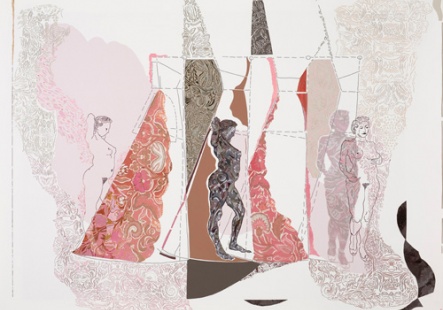Printmaking Today-Charlotte Hodes
27/03/2015
Printmaking Today-Charlotte Hodes
Charlotte Hodes’s work occupies the interface between feminist thought and the history of the decorative arts. Last year, she exhibited a large body of work using paper cut and ceramic techniques to interrogate the seminal 19th-century publication The Grammar of Ornament (1856) by architect and designer Owen Jones5 and investigate the relationship between the female form in painting and the decorative arts. Three paper cuts and three ceramic vases from that series are included in the Good Figure exhibition.
Hodes’s female form here asserts her refusal to be simply a decorative presence; in the process, she escapes the rigid rules of traditional roles and disrupts the visual order. She recalls: “I was a student from the late 1970s when political feminism was prominent among artists at the Slade. This was quite tough for me as these artists moved into film, installation and performance. I knew by then that I was at heart a painter and committed to the material of paint as a powerful means of communication. I struggled with how to find my own path.”6
Based on perceptual drawing, particularly life drawing, Hodes’s females are portrayed in silhouette form, draped over, or dancing on, large collaged works and ceramic pots. She explains: “The vase is a surrogate for the female figure and the form of the vase carries its own art history that informs one’s understanding of what is represented on it. I feel that my female silhouette, depicted on the vase, makes a claim to this, the status of an ‘archetypal’ form. I am not concerned with sculptural form per se, or with the material of clay, but with the surface that is an alternative substrate to the canvas. The vase shape is therefore part of the image.”7
The female figure within a decorative context enables the concealment of her nudity and thus establishes a screen by which to protect the artist’s vulnerability: “I hope that the figures engage with the long tradition of the decorative arts and, although they might appear compliant, my work does not support the traditional notion of the male ‘gaze’. Rather it concerns the figure that has chosen to be represented: pleasure can thus be experienced through the membrane of the silhouette. In formal terms, the choice of silhouette enables a light-hearted quality to be presented; as they are not fully executed forms, humour can be evoked without undermining the seriousness of the work. This also is a challenge to the ‘hard-won image’, which was also a dominant force while I was a student at the Slade. And that is not to say that making images is easy, as they never are. They are always a struggle.”
Whole article link:
http://www.studiointernational.com/index.php/good-figures-review-female-...

